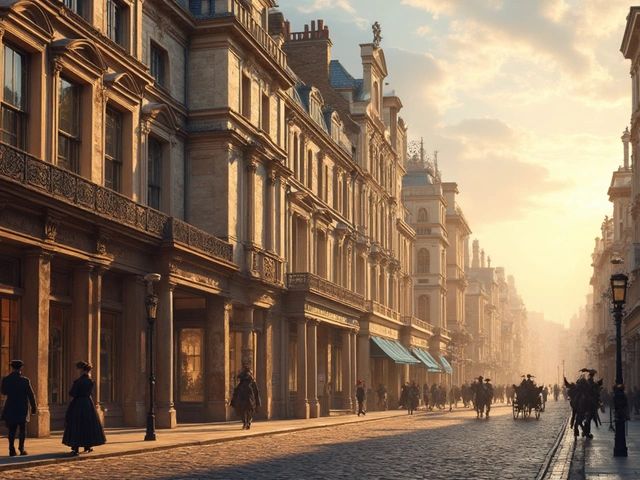Why do people still stop and stare at those grand, ornate buildings with soaring columns and sculpted facades? You see one of these masterpieces and just feel transported—suddenly, it’s as if you're in 15th-century Florence, but really you’re on a busy street in New York or Paris. That’s the magic of Renaissance Revival Architecture. It’s built on the bones and beauty of a golden age, but adapted for new cities, new nations, and new dreams. This isn’t just nostalgia; it’s confidence, stability, and a little bit of showing off… and let’s be honest, who doesn’t enjoy a bit of that every now and then?
The Heart of Revival: Where History Meets Ambition
Here’s a fact that might surprise you—Renaissance Revival didn’t even begin during the Renaissance. The original Renaissance ran from the 14th to 17th centuries in Italy, but the "Revival" part came centuries later, especially in the 1800s. What sparked it? Well, a lot of folks wanted to look and feel as cultured and powerful as the popes and princes who first built those Italian palazzi. Europe in the 19th century was exploding with energy—industry, science, exploration. There was both a hunger for progress and, oddly enough, a craving for something stable, time-tested. Renaissance style offered both: it symbolized genius and harmony, but also suggested you knew your roots.
The story begins with architects in England and France digging through history books, sketching cathedrals and palaces from the past, then mixing in new technologies. London’s National Gallery (the original section), finished in 1838, nods to those Italian roots with its domed central portico and long wings. Across the Channel, wealthy Parisians wanted show-off mansions that whispered old money and culture. If you travel in Berlin, Vienna, or even Budapest, you’ll spot public buildings dressed up with domed roofs, symmetrical facades, arched windows, and classical columns—each one basically saying "I’m important, look at me!" By the late 19th and early 20th centuries, the trend went global: you’ll catch its echoes in chic Buenos Aires, stately Ottawa, and boomtowns of the American Midwest.
America was a special case. As cities such as Chicago and New York wanted to show they belonged on the world stage, they built courthouses, banks, and even train stations bursting with Renaissance Revival flair. Boston’s Copley Square, with its picturesque mix of styles, wouldn’t be the same without the iconic Boston Public Library, opened in 1895 and still known for its "palace for the people" slogan. You saw this vibe not only in public architecture but in hotels, mansions, and private clubs—each promising a little piece of Florence or Venice tucked away behind doors that, if you’re lucky, are still open to visitors today.
What really set Renaissance Revival apart from earlier revivals? It was a bit cheeky. While Gothic Revival looked upward with its spires and tried to inspire piety, Renaissance Revival was about balance, form, and celebration of human achievement. It wasn’t shy—this style used symmetry to show power, grand staircases to hint at drama, and lots of sculpted faces and elaborate details because… well, why not? There was a lot of artistry and a bit of showing off, but always done with a smile.
Want a fun tip next time you’re exploring a city? Look for the most imposing, symmetrical building in a square or along a boulevard, and count the number of arches, pilasters, and decorative medallions. If it feels like you’ve jumped back in time and could picture someone in a toga or velvet gown breezing down the steps, you’ve probably found a piece of Renaissance Revival history in plain sight.
Details that Dazzle: Breaking Down Renaissance Revival Style
So, what makes a Renaissance Revival building instantly recognizable? For starters, architects borrowed heavily from actual Renaissance alchemists—think Brunelleschi and Alberti—but weren’t afraid to tip the scale toward flamboyance. Here’s what to keep your eyes peeled for:
- Symmetry and Geometry: What you’ll usually spot first is the perfect balance. Left mirrors right, and every window and door is carefully lined up. This harmony reached back to ancient Roman ideals, but updated for the 19th-century city buzz.
- Columns and Pilasters: These are everywhere. Most are round or slightly flattened, often supporting heavy entablatures with big, bold cornices. Look closely—a lot are purely decorative. They’re like the architectural version of a designer belt, hinting at heritage.
- Arched Windows and Doorways: The classic semi-circular arch gets top billing. In fact, nothing says "Renaissance Revival" quite like a rhythm of arches across the facade, sometimes topped with ornate keystones or intricate carvings. It makes even the most imposing bank seem welcoming… or at least impressive enough to trust with your life savings.
- Rustication: You can’t miss those big, deeply grooved stones or blocks carved to look rough-and-ready on the ground floor. This treatment creates a kind of fortress base, making the building appear solid and unshakeable—even if it’s just an aesthetic trick.
- Ornamentation Galore: Medallions, busts, garlands, and cornice details. No shame in a little excess here; more is definitely more. You’ll often see mythological faces, lions, or even cherubs peeking down from unexpected spots. Each one is like a wink from the past.
- Mansard Roofs (Sometimes): Especially in France or French-influenced cities, the top floor sports a steeply-pitched roof, often with dormer windows—it adds an extra layer of drama and says, “I belong in a fairy tale.”
Sometimes the style goes full fantasy. In Prague, Vienna, and St. Petersburg, public theaters and museums become stage sets in themselves, with columned porticoes, oversized statues, and dramatic lighting. In America, look at the Metropolitan Museum of Art—the older wings layer Italian Renaissance with French twists—all to impress, inspire, and sometimes intimidate.
But here’s another twist: this wasn’t just for show. Renaissance Revival buildings often included some cutting-edge technology under their old-fashioned skins. Famous Chicago architect Richard Morris Hunt used steel and new construction methods to create grand spaces without the thick, claustrophobic walls of older styles. This blend of old and new made the buildings both breathtaking and practical—many are still in use, which is saying something.
If you love DIY and have a soft spot for this grandeur, you can borrow some elements at home. Try a symmetrical layout for your garden, or add a circular mirror above the mantel for a subtle nod to those arched windows. Even ornate plasterwork or faux pilasters can bring a touch of Renaissance Revival charm to an apartment or a small house—no palace required.
Still, nothing compares to seeing the real thing. Stand in the echoing lobby of a Renaissance Revival library or watch sunlight stream through tall arched windows in a historic hotel, and you get why this style never really went out of fashion. Its details—the scrollwork, the sense of weight and grandeur—just make everything around you a little more cinematic.
Legacy and Continued Inspiration: Why It Still Matters
It’s wild to think a style born out of a longing for the past could feel so fresh in the present. But that’s exactly what happens with Renaissance Revival Architecture. The style has survived the push toward glass boxes and minimalist chic because there’s something just irresistible about its mix of comfort, opulence, and timelessness. Cities like New York and Paris still fight to protect these buildings, even as property values skyrocket—nobody wants to lose a piece of their golden age.
Take the example of the Philadelphia City Hall. It’s not just a government center; it’s a daily Instagram star, a wedding backdrop, and even a set for blockbuster movies. Walking past it on a sunny afternoon, you spot tourists craning their necks to snap the clock tower, locals grumbling about the sheer scale, and lots of kids doing their best superhero poses on the steps. That’s life, swirling around stone and statuary that were put up almost 150 years ago.
Besides the wow factor, Renaissance Revival buildings often sparked a sense of civic pride and a shared identity. When a city or a private club went for this style, it wasn’t just about beauty; it was a way of saying, “We belong to something bigger.” At a time when new nations and cities wanted to cement their place in the world, these designs offered both stability and a bit of artistic swagger.
Like trends in fashion, bits and pieces come roaring back every now and then. Developers today still borrow from Renaissance Revival—sometimes using laser-cut panels to echo a leaf motif, or mixing classic columned entrances with glass-and-steel additions. If you take a walk through recently opened public spaces or look at the new crop of boutique hotels, you’ll notice those old curves and balanced layouts sneak in between newer elements. It’s no accident—designers know people crave both tradition and comfort, especially after the stress and uncertainty of the past few years.
One quirky fact: Renaissance Revival has become hugely popular again for stage sets and movie backdrops. Ever notice how so many fantasy shows and period dramas plop their actors into ballrooms with soaring ceilings, big arched windows, and gold accents? That’s no accident; this look practically screams "epic story happening here."
If you’re a traveler chasing inspiration, add the Renaissance Revival masterpieces of Vienna’s Ringstrasse, London's V&A Museum, or the grand halls of Washington, D.C.'s Library of Congress to your must-see list. Take a notebook—or your phone—and capture not just the main architecture but the little hidden details: a carved leaf in a corner, a tiny balcony high above, or the silent drama of stone figures watching the crowds pass by. Sometimes those small moments tell bigger stories than the grand facades themselves.
What’s next? The story isn’t over. As cities grapple with blending old and new, Renaissance Revival shows how you can borrow liberally from the past without feeling stale. If you’re an architect, a design lover, or simply curious, dig into local histories and see how your own city has played with these timeless themes. The golden age might officially be centuries behind us, but its spirit keeps echoing from every carved stone and sunlit arch—right there, waiting to spark a fresh wave of imagination today.




